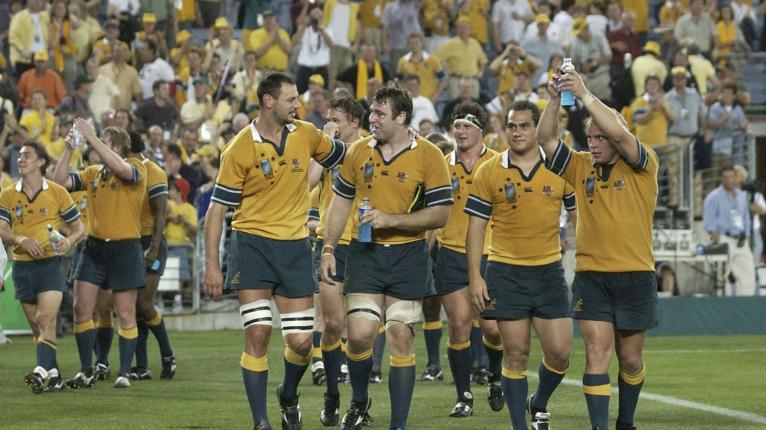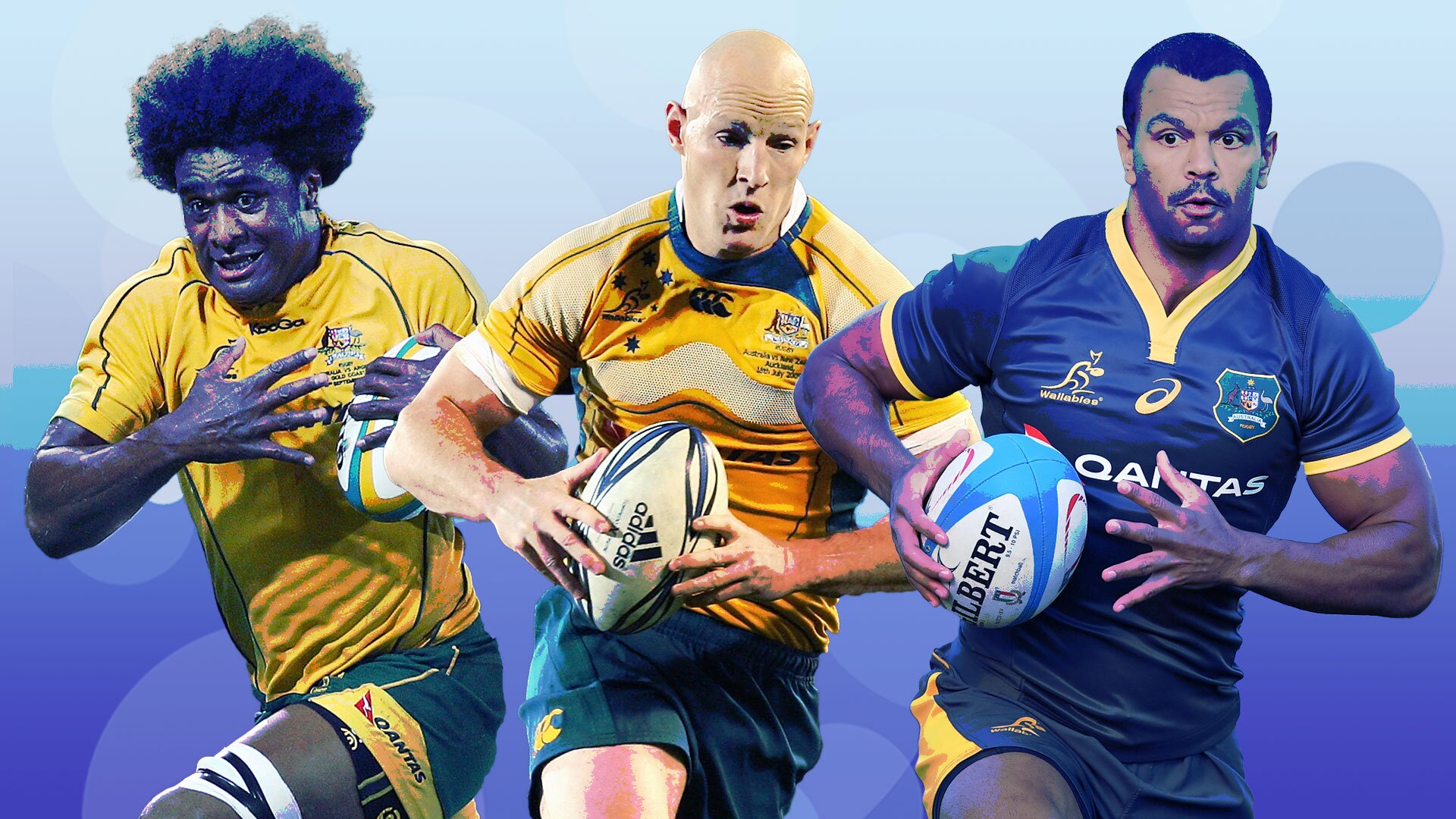Australia's diminishing class: how the 2019 squad compares to previous years

It’s been a steady decline for the Wallabies over the years.
Heading into the 2003 World Cup, Australia were ranked 4th in the just-introduced World Rankings – just a whisker behind 3rd ranked Ireland. The 2011 side were perched near the top of the rankings in 2nd place, sandwiched between New Zealand and South Africa.
As we approach the 2019 competition, however, Australia are ranked a lowly 7th in the world. Their lowest-ever rank was ‘achieved’ in 2018 but a poor showing at the World Cup could see them finish even lower than that, given that double points are on offer.
These rankings shouldn’t come as a surprise. After all, results have starting drying up for the men in gold in recent times. The Wallabies have managed just four wins over heavyweights New Zealand, South Africa, England and Ireland in the four years since the last World Cup. All of those victories have come at Suncorp Stadium in Queensland.

There are a number of factors at play, but one of the more obvious contributors is the lack of world-class players.
The recent success of the Australian Under 20 side at the World Championship suggests that there is ample talent coming through the ranks, but for whatever reasons they’re not being converted into top-tier international players.
Gone are the days of the Stephen Larkhams, the Sterling Mortlocks and the Dan Vickermans.
Today we compare the Wallabies sides that competed in the 2003 World Cup final, the 2011 World Cup semi-final and the upcoming Bledisloe Cup match-up with New Zealand to assess what kind of stock Australia has access to.
Front Row
2003: Bill Young, Brendan Cannon, Al Baxter
2011: Sekope Kepu, Stephen Moore, Ben Alexander
2019: Scott Sio, Tolu Latu, Allan Alaalatoa
Although the Wallabies have traditionally always been one of the best sides in world rugby, they’ve rarely been able to field a front row that opposition would ever describe as fearsome.
Over the last decade, that’s slowly been changing.
The 2003 contingent of Young, Cannon and Baxter were all dynamic around the park, but they certainly weren’t up with the likes of Phil Vickery, Greg Somerville or John Hayes.
The 2011 trio made massive strides and, despite going through periods of finding themselves on the wrong side of referees’ calls, they always eventually adjusted to put themselves in a pretty good position heading in the World Cup.
In 2019, however, the Wallabies have a raft of props that’re up with the best. They’ve shaped up in their scrummaging and are still just as dynamic around the park – especially when Taniela Tupou is injected onto the field. The All Blacks have a good front row, but the Wallabies will feel like they can get parity with their neighbours over the ditch.
The hooking situation now is still fairly dicey, however, and Tolu Latu has been granted a start for this weekend’s match after two fine performances from Folau Fainga’a.
Ranking: 2019 > 2011 > 2003
Locks
2003: Justin Harrison, Nathan Sharpe
2011: Dan Vickerman, James Horwill
2019: Izack Rodda, Rory Arnold
For all the ground that Australia have made up in the front row, their locks certainly don’t measure up to what Wallabies fans were once used to.
Harrison, Sharpe, Vickerman and Horwill are all men that have been celebrated at both Super Rugby and international level for their years of experience and all-round ability. It’s obviously early days yet for Rodda and Arnold, but it’s hard to imagine them going down as greats of the game.
When Australia hosted the World Cup in 2003, however, the Harrison-Sharpe combo was still fairly new, with just 30 caps between them. Both players had amassed plenty of game time for their respective Super Rugby sides, however, and had earned selection after a string of strong performances.
Whilst Rodda and Arnold are more experienced than their 2003-counterparts, they’ve been thrust into the limelight more on account of there being few genuine contenders for the 4 and 5 jerseys.
The 2011 pairing of Vickerman and Horwill, in contrast, oozed class. Horwill was the captain of the side and Vickerman was an intelligent operator – both on and off the field.
Ranking: 2011 > 2003 > 2019
Loose Forwards
2003: George Smith, Phil Waugh, David Lyons
2011: Rocky Elsom, David Pocock, Radike Samo
2019: Lukhan Salakai-Loto, Michael Hooper, Isi Naisarani
Despite their falling stocks, the Wallabies have always had a good cohort of loose forwards – particularly on the openside. Waugh, Smith, Pocock and Hooper are four of the best openside flankers you’ll ever see doing the rounds – it’s just a pity the men around them haven’t always been of the same standard.
Three classy players combine in 2003, with Waugh and Smith excellent in the breakdowns and Lyons a strong carrier. Waugh was deemed Australia’s player of the year in 2003 and Lyons took out the prize a year later – showing the importance of both men.
The cohort in 2011 wasn’t quite as strong – with Pocock being the obvious exception. Still, you have to feel like the back row had a slightly better balance with Elsom playing on the blindside flank, compared to Smith in 2003.
Hooper aside, the current loose trio is relatively inexperienced compared to the back rows of yesteryear. Naisarani has the potential to be excellent for the Wallabies and showed plenty of form for the Rebels this year, while Salakai-Loto hasn’t offered too much in his two starts in 2019.
Ranking: 2003 > 2011 > 2019
Halves
2003: George Gregan, Stephen Larkham
2011: Will Genia, Quade Cooper
2019: Nic White, Christian Lealiifano
It’s unlikely that Australia will ever be blessed again in the halves as they were in the early 2000s. Gregan was brilliantly skilful but also a top-notch captain and commander. Outside him, Larkham was a safe pair of hands to guide the Wallabies around the park and also offered enough on attack that the defenders couldn’t just drift onto the midfielders when ‘Bernie’ had the ball.
Perhaps the duo of Genia and Cooper could have pushed Gregan and Larkham for a claim as the Wallabies’ best halves combination – they certainly had plenty of promise. Genia, in particular, is an excellent passer and possesses many of the same traits as Gregan but probably left Australia before he reached his potential and hasn’t quite looked as sharp since his return – evidenced by the fact that White has gotten the go-ahead for Saturday night. Cooper is an enigma that can set the world alight one day and then have an absolute stinker the next.
Still, both pairings have the advantage over the White-Lealiifano axis – which looks fairly safe but lacks any real X-factor. They’re a smart duo that will boss the Wallabies around the park well, but don’t expect them to create too much on their own.
Curiously, all three pairings played together at Super Rugby level: Gregan and Larkham and White and Lealiifano at the Brumbies, as well as Genia and Cooper at the Reds and Rebels.
Ranking: 2003 > 2011 > 2019
Midfield
2003: Elton Flatley, Stirling Mortlock
2011: Pat McCabe, Anthony Fainga’a
2019: Samu Kerevi, James O’Connor
If there’s one area where the 2019 crop has arguably more talent, it’s in the centres. Kerevi and O’Connor are individually excellent players. Both have ample X-factor (although O’Connor has lost a bit of the spark that made him so dangerous in his early years) and their combination could be very well-balanced. They’ve also collectively accrued over 70 test matches. Unfortunately, we’re yet to see this combination in action.
Contrast that with the combination of Flatley and Mortlock that excelled at the World Cup in 2003. They were both in the relatively early stages in their careers, with both players having fewer than 30 caps before the tournament kicked off – but they’d achieved enough at the international level that there would have been no concerns about their experience. Arguably neither player had the physical dominance of Kerevi or the ball-playing skills of O’Connor – but they were both considerably more complete players than either of the 2019 starters.
The less said about the 2011 midfield the better. It was somewhat of a miracle that ether McCabe or Fainga’a made onto the international stage – let alone started in a World Cup semi-final.
Ranking: 2003 > 2019 > 2011
Outside Backs
2003: Lote Tuqiri, Wendell Sailor, Mat Rogers
2011: Digby Ioane, James O’Connor, Adam Ashley-Cooper
2019: Marika Koroibete, Reece Hodge, Kurtley Beale
Like the loose forwards, there has rarely been a lack of respectable outside backs doing the rounds for the Wallabies.
That being said, Michael Cheika still doesn’t look to have quite found the right balance with his current players. Koroibete has his moments on attack but has found himself stood up on defence by more nimble opposition. Hodge has the opposite issue – safe on defence, but his skills are better suited to setting up his teammates than doing any damage himself. Beale is a great talent, no doubt about it, but it still feels like the utility has never really lived up to his potential in the backfield for the Wallabies.
Compare that back three to the 2003 and 2011 squads, and it’s easy to see which era of players comes up trumps. The beaten finalists, Tuqiri, Sailor and Rogers, were all excellent attackers, with Rogers brilliant at setting up those around him. Tuqiri and Sailor were as good finishers as any – not necessarily as quick as some others doing the rounds, but able to throw their weight around a bit more.
The 2011 trio probably had the perfect combination of skill, speed and strength. O’Connor would have done a good job anywhere in the backline and made the most of his skills, not confining himself to the left wing even though that was his designated position. Ioane was one of the form wings in 2011 and was a danger any time he got his hands on the ball. Ashley-Cooper was the perfect foil, safe as houses at the back but also quick enough to create plays – and smart enough to know when to push passes and when to hold off.
Ranking: 2011 > 2003 > 2019













































































